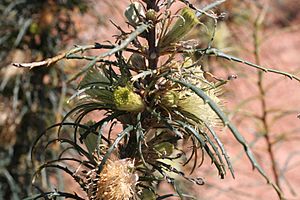Banksia strictifolia facts for kids
Quick facts for kids Banksia strictifolia |
|
|---|---|
 |
|
| Near Hill River | |
| Scientific classification | |
| Genus: |
Banksia
|
| Species: |
strictifolia
|
| Synonyms | |
|
Dryandra stricta A.S.George |
|
Banksia strictifolia is a type of bushy plant. It grows only in Western Australia. This plant has long, narrow leaves with sharp teeth along the edges. Its flowers are creamy yellow and grow in groups of 45 to 85. After flowering, it produces small, egg-shaped fruits called follicles.
What Does It Look Like?
Banksia strictifolia is a bushy plant. It usually grows up to 3 m (9.8 ft) tall. This plant does not form a lignotuber, which is a woody swelling at the base of some plants.
Its stems are smooth, without hairs. The leaves are long and narrow, measuring 50–200 mm (2.0–7.9 in) in length. They are about 4–9 mm (0.16–0.35 in) wide. Each leaf sits on a small stalk called a petiole, which is up to 5 mm (0.20 in) long.
The leaves have 8 to 18 sharp, triangular teeth on each side. The flowers grow in special groups called heads. Each head has between 45 and 85 creamy yellow flowers.
At the base of each flower head are small, hairy leaves called bracts. These bracts can be up to 13 mm (0.51 in) long. Each flower has a part called a perianth, which is 23–35 mm (0.91–1.38 in) long. The plant also has a straight pistil, which is the female part of the flower, measuring 23–25 mm (0.91–0.98 in) long.
This banksia flowers from August to October. After the flowers, it grows small, slightly hairy fruits. These fruits are egg-shaped or round and are about 6–8 mm (0.24–0.31 in) long.
How It Got Its Name
This banksia was first officially described in 1996. A scientist named Alex George gave it the name Dryandra stricta. He found the first samples of this plant near the Brand Highway in Regans Ford in 1986.
Later, in 2007, two other scientists, Austin Mast and Kevin Thiele, moved all Dryandra plants into the Banksia group. However, the name Banksia stricta was already used for a different plant. So, Mast and Thiele changed the name to Banksia strictifolia.
The name strictifolia comes from two Latin words. Strictus means "straight," and -folius means "leaved." So, the name means "straight-leaved banksia."
Where It Lives
Banksia strictifolia grows in an area called kwongan. This type of land is found between Three Springs and Badgingarra in Western Australia.
Is It Endangered?
The Western Australian Government's Department of Parks and Wildlife says this banksia is "not threatened." This means it is not currently at risk of disappearing.

